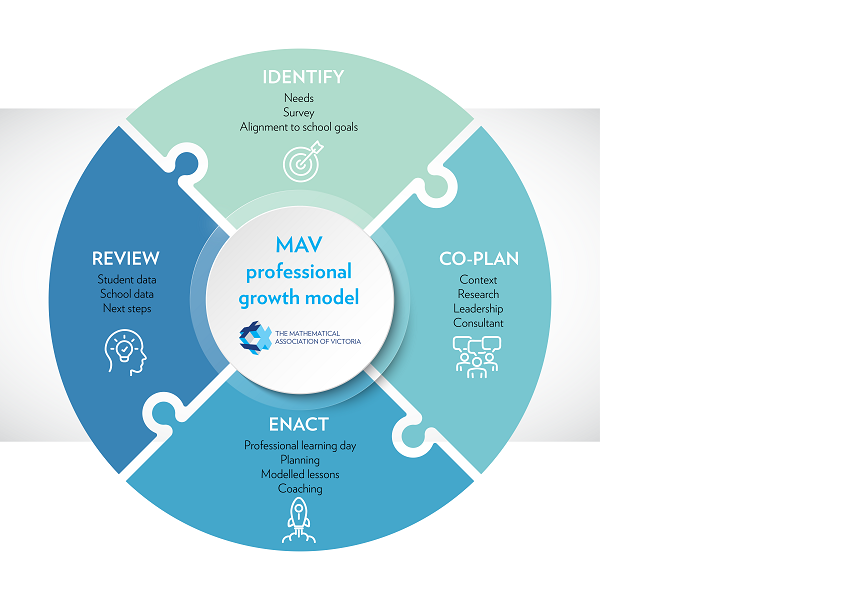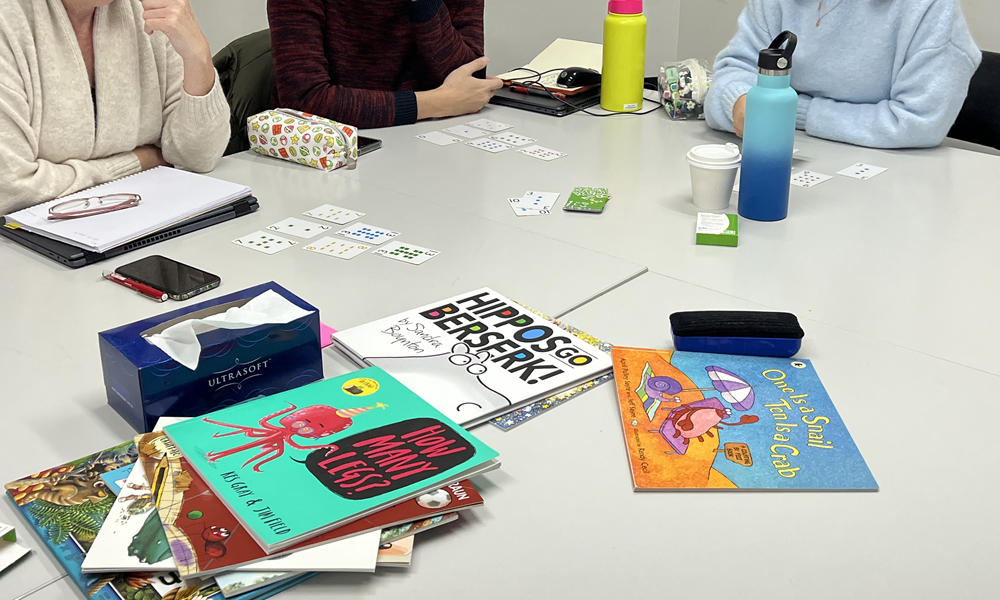A common vehicle for schools to support professional learning and development goals is engaging with a relevant subject association. In this Q&A, we’re joined by Renee Ladner, Primary Education Consultant at the Mathematical Association of Victoria.
Renee and her colleagues presented on a panel at Research Conference 2025 earlier this year, where they reflected on the process of embedding school-wide change in primary mathematics education. Here, Ladner shares the process leadership teams can follow for engaging with an association, and 2 examples of school partnerships.
Hi Renee, can you tell Teacher readers about your role and the kind of work you do in schools?
At the Mathematical Association of Victoria (MAV), my role is a Primary Education Consultant. Our education team is made up of our CEO, Jen Bowden, Di, Danijela, Leonie, and Jess.
There are projects that we work on in partnerships, such as the Department of Education, Victorian Academy of Teaching and Leadership (VATL) and even the ABC. But most importantly, my main role is to support school leaders and teachers in their roles to ensure best practice for Mathematics education.
Currently MAV is partnering with around 30 schools from all sectors around Victoria delivering professional learning; planning with leadership and teachers; coaching of leaders and teachers in the classroom and building their professional capacity for what is currently pertinent to them.
More broadly, how does MAV work with schools?
School leaders tend to engage the MAV to help plan a bespoke professional learning experience for their school. Some schools may receive external grants or funding to support this. MAV members receive a discount. If your school is a member of MAV, then automatically every teacher in the school will be too. Alternatively, some teachers choose to be individual members.
When schools engage with the MAV, they are matched with a consultant who complements their unique needs. Schools’ requirements and budgets do vary so we are able to design a program that is based on contemporary research, the context of the school and the timeline required. Depending on where the school is in their professional learning plan, it may involve after-school or whole day professional learning, or an ongoing regular cycle of consulting.
We follow the professional growth model (pictured below) when working with schools regardless of the length of professional development.

[Image: The Mathematical Association of Victoria]
Once consultants have completed professional learning delivery at a school, the MAV Education Team continue to follow up with school leaders to discuss their progress or where there may be gaps that need to be part of another cycle in the future. We are always available to talk through contemporary pedagogical practices, content advice, coaching and feedback cycles as well. We always encourage schools to continue to be a part of our online learning topics that are delivered each term via webinars.
You’ve been involved in lots of great professional development programs. Can you share examples?
We have! Our recent and ongoing partnership with Derrimut Primary School (DPS) in Melbourne’s western suburbs has been a really fulfilling journey. Sarah Pinder is the Mathematics Leader at DPS and has been pivotal in shaping the outcomes for teachers and students, both academically and from a wellbeing perspective.
They initially engaged us when the school expanded and took on many new teachers (mainly graduates), a new leadership team and a culturally and economically diverse community. The leadership team’s goals were to:
- create consistent and predictable routines for teachers and students to ensure a positive climate for learning for all
- build staff mathematical content knowledge (MCK) and pedagogical content knowledge (PCK) to plan and deliver effective learning experiences aligned to an instructional model that was created and refined by the teachers and leaders
Together, we devised a professional learning plan. We began by modelling what the teaching of rich tasks can look like within the DPS instructional model. The focus was for teachers to watch our consultant model the lesson and take note of what they were doing to engage students, explicitly teach content, check for understanding, enable and extend and summarise the learning of the lesson; and then to set goals for themselves to trial in the classroom before the consultant returned either a fortnight or month later.
There was a focus on the teacher listening more, talking less, and asking intentional questions to ensure understanding from students. This gave teachers the confidence in knowing their students and how they learnt; it also equipped them with strategies to continue moving all students along their trajectory of learning.
The MAV consultant would also plan with teachers for upcoming units of work. In this situation the MAV consultant could deliver the research around the topic (for example, additive thinking) and link it into the tasks and problems that could be included in the planning. Having done the tasks and anticipating what their own students might do, it empowered teachers to know exactly what they were looking for and be prepared to differentiate at any time throughout the lesson, giving students agency in how they may present and articulate their thinking.
DPS are beginning to see a shift in NAPLAN data in Numeracy, where there is a closing gap between not equity funded students and equity funded students. There has been a 10% growth in year 3 between 2023 and 2024 of equity funded students moving into strong proficiency in Mathematics, and the additional support band of 33% of equity funded students dropped to 18% within 12 months.
Another recent experience I personally was a part of was working with Western English Language School (Secondary). The context is quite different than any mainstream school where new arrival students would attend the setting for anywhere between 6 and 12 months. They would arrive with varying school and English experience.
The principal holds very high standards for these students, ensuring they are being taught at their level of need. The staff at the school equally hold the same values and are always wanting to see their students become best prepared to enter mainstream schooling. Through goal identification, the school acknowledged that they required MCK to be enhanced for teachers, which required first being taught to the Mathematics Leadership team. Over the course of a year, the team and I met monthly, and we worked through the Big Ideas in Number, Measurement and Probability and Statistics to identify common misconceptions that students develop and can maintain throughout their mathematical learning journey.
From there, we worked to build a ‘toolbox’ for a range of mathematical topics, such as Additive Thinking and Measurement. In the toolbox was a variety of pedagogical choices for teachers involving games, problem solving tasks and more. For each topic we broke down the language required for students to access the key concepts required to translate to a textbook or the like when moving into a different educational setting. We also created a bank of resources and assessments that could be applied. Given the teachers were the experts in how to teach English as another language, I relied on them to translate how they felt it would best suit their students.
It was an enormous amount of work and commitment undertaken by the team, but they felt it was valuable and really focused their classroom teaching to be able to assess accurately and move students along their learning path. The team redesigned their entry assessment used to group students based on their MCK. There was a focus as well, where possible, to ensure students had more than a surface knowledge on a topic and to ensure they could apply a Concrete Representational and Abstract (CRA) approach to their learning.
A reflection from the team was: ‘Our work with MAV over the past year has trained us, who are not Maths-trained teachers, to understand the concepts of mathematics so that we can then make informed decisions about which aspects of all of mathematics are appropriate for us, in a new arrivals setting, to teach to our students. We have learnt this through engaging activities that have both provided us with a deeper understanding of the concepts and given us ideas about how to teach these concepts. Finally, the introduction to the Big Ideas of Number has revolutionised our thinking about the teaching and learning and scope and sequence of Mathematics education.’
I personally visited the classrooms to see how the teachers were enacting their knowledge and the response from students was great. I witnessed students excited to use manipulatives and make meaning of what they were doing by connecting it with language, symbols and pictorial representations. The next stage for Western English Language School is to translate their learnings to the rest of the staff who are also teaching Mathematics and to refine their planning approaches.
What is MAV’s focus for this school year?
In the last 12 months or so, the Department of Education has released a revised Victorian Teaching and Learning Model (VTLM) 2.0 and Melbourne Archdiocese Catholic Schools (MACS) released and are implementing the Vision for Instruction. There has been an increased emphasis on cognitive science and how the brain best retains and applies new information. This is interesting in Mathematics, and necessary to continue to refine planning and teaching practices.
Our role is to support schools in what explicit teaching looks like in their context and how it will best service their students to see the results school wide. We will continue to work with schools supporting them through professional development, based on relevant research for our schools here in Victoria and Australia, coaching in the classroom, and goal setting with them to achieve their teaching and learning goals that match their School Improvement Plan/Annual Action Plan or similar documents. First and foremost, we are here to support our great teachers and leaders.
We are also continuing our other great programs such as our student activities, professional learning opportunities and events for teachers and leaders. We are also working with the VATL to present the Leading Mathematics program for school leaders and teachers as well as supporting their Teaching Excellence Program (TEP).
References
The Mathematical Association of Victoria. (n.d.). [Image of the MAV professional growth model]. https://www.mav.vic.edu.au/Services-and-News/In-School-Consulting
Thinking about the subject you teach, what associations provide support and expertise? Is a colleague of yours, or perhaps your school, already a member? How could this help with your own teaching and professional development needs?



